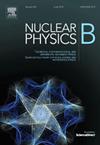大黄蜂引力中具有宇宙学常数和全局单极子的球对称黑洞的拟正态模
IF 2.8
3区 物理与天体物理
Q2 PHYSICS, PARTICLES & FIELDS
引用次数: 0
摘要
本文在具有全局单极子和宇宙学常数的爱因斯坦-大黄蜂引力模型框架下,研究了球对称黑洞的标量、电磁场和狄拉克场摄动。本文应用Newman-Penrose (NP)形式的Klein-Gordon方程、电磁场方程和Dirac方程研究了有效势、灰体因子和拟正态模态(QNMs)。利用一般的严格界法,导出了标量场、电磁场和狄拉克场的灰体因子。应用六阶WKB近似和pad本文章由计算机程序翻译,如有差异,请以英文原文为准。
Quasinormal modes of spherically symmetric black hole with cosmological constant and global monopole in bumblebee gravity
This paper studies the scalar, electromagnetic field and Dirac field perturbations of a spherically symmetric black hole within the framework of the Einstein-bumblebee gravity model with a global monopole and cosmological constant. We investigate the effective potentials, greybody factors and quasinormal modes (QNMs) by applying the Klein-Gordon equation, electromagnetic field equation and Dirac equation expressed in the Newman-Penrose (NP) formalism. Using the general method of rigorous bound, the greybody factors of scalar, electromagnetic and Dirac field are derived. Applying the sixth order WKB approximation and Padé approximation, the QNM frequencies are derived. We also discuss the impact of global monopole η, cosmological constant Λ and Lorentz violation parameter L to the effective potential, greybody factor and QNMs. Increasing the parameter η prevents the rise of effective potential for both Schwarzschild-de Sitter (SdS)-like and Schwarzschild-Anti de Sitter (SAdS)-like black holes with global monopole and consequently increases the greybody factors. However, decreasing the parameter L reduces the rise of effective potential for the SAdS-like black hole with global monopole and it increases the greybody factor but increasing the parameter L has the opposite effect for the SdS-like black hole with global monopole. It is also shown that the shadow radius increases with increasing the parameter η for both the SdS and SAdS-like black holes. Increasing the value of L tends to decrease the shadow radius for the SdS-like black hole but it has the opposite effect in the SAdS-like black hole. A careful studying is being carried out to investigate how the absorption cross-section gets affected when the parameter L appears into the picture.
求助全文
通过发布文献求助,成功后即可免费获取论文全文。
去求助
来源期刊

Nuclear Physics B
物理-物理:粒子与场物理
CiteScore
5.50
自引率
7.10%
发文量
302
审稿时长
1 months
期刊介绍:
Nuclear Physics B focuses on the domain of high energy physics, quantum field theory, statistical systems, and mathematical physics, and includes four main sections: high energy physics - phenomenology, high energy physics - theory, high energy physics - experiment, and quantum field theory, statistical systems, and mathematical physics. The emphasis is on original research papers (Frontiers Articles or Full Length Articles), but Review Articles are also welcome.
 求助内容:
求助内容: 应助结果提醒方式:
应助结果提醒方式:


